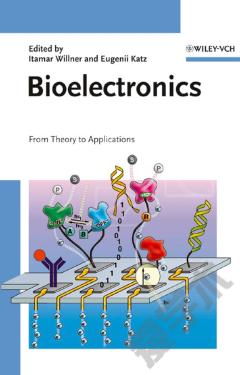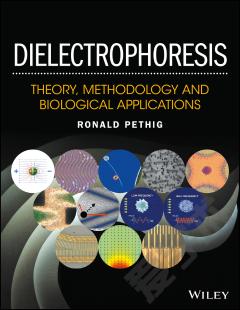Bioelectronics —— From Theory to Applications
----- 生物电子学:从理论到应用
Preface.List of Contributors.1 Bioelectronics - An Introduction (Itamar Willner and Eugenii Katz).2 Electron Transfer Through Proteins (Jay R. Winkler, HarryB.Gray, TatianaR. Prytkova, Igor V. Kurnikov, and David N. Beratan).2.1 Electronic Energy Landscapes.2.2 Theory of Electron Tunneling.2.3 Tunneling Pathways.2.4 Coupling-limited ET Rates and Tests of the Pathway Model.2.5 Multiple Tunneling PathwayModels.2.6 Interprotein Electron Transfer: Docking and Tunneling.2.7 Some New Directions in Electron Transfer Theory and Experiment.2.8 Concluding Remarks.3 Reconstituted Redox Enzymes on Electrodes: From Fundamental Understanding of Electron Transfer at Functionalized Electrode Interfaces to Biosensor and Biofuel Cell Applications (BilhaWillner and ItamarWillner).3.1 Introduction.3.2 Electrodes Functionalized with Reconstituted Redox Proteins.3.3 Electrical Contacting of Redox Proteins by Cross-linking of Cofactor-Enzyme Affinity Complexes on Surfaces.3.4 Reconstituted Enzyme-Electrodes for Biofuel Cell Design.3.5 Conclusions and Perspectives.4 Application of Electrically Contacted Enzymes for Biosensors (FriederW. Scheller, Fred Lisdat, and Ulla Wollenberger).4.1 Introduction.4.2 Biosensors - Precursors of Bioelectronics.4.3 Via Miniaturization to Sensor Arrays - The Biochip.4.4 The Route to Electrically Contacted Enzymes in Biosensors.4.5 Routine Applications of Enzyme Electrodes.4.6 Research Applications of Directly Contacted Proteins.4.7 Conclusions.5 Electrochemical DNA Sensors (Emil Palecek and Miroslav Fojta).5.1 Introduction.5.2 Natural Electroactivity and Labeling of Nucleic Acids.5.3 Sensors for DNA and RNA Hybridization.5.4 Sensors for DNA Damage.6 Probing Biomaterials on Surfaces at the Single Molecule Level for Bioelectronics (Barry D. Fleming, Shamus J. O'Reilly, and H. Allen O. Hill).6.1 Methods for Achieving Controlled Adsorption of Biomolecules.6.2 Methods for Investigating Adsorbed Biomolecules.6.3 Surfaces Patterned with Biomolecules.6.4 Attempts at Addressing Single Biomolecules.6.5 Conclusions.7 Interfacing Biological Molecules with Group IV Semiconductors for Bioelectronic Sensing (Robert J. Hamers).7.1 Introduction.7.2 Semiconductor Substrates for Bioelectronics.7.3 Chemical Functionalization.7.4 Electrical Characterization of DNA-modified Surfaces.7.5 Extension to Antibody-Antigen Detection.7.6 Summary.8 Biomaterial-nanoparticle Hybrid Systems for Sensing and Electronic Devices (JosephWang, Eugenii Katz, and ItamarWillner).8.1 Introduction.8.2 Biomaterial-nanoparticle Systems for Bioelectrochemical Applications.8.3 Application of Redox-functionalized Magnetic Particles for Triggering and Enhancement of Electrocatalytic and Bioelectrocatalytic Processes.8.4 Conclusions and Perspectives.9 DNA-templated Electronics (Kinneret Keren, Uri Sivan, and Erez Braun).9.1 Introduction and Background.9.2 DNA-templated Electronics.9.3 DNA Metallization.9.4 Sequence-specific Molecular Lithography.9.5 Self-assembly of a DNA-templated Carbon Nanotube Field-effect Transistor.9.6 Summary and Perspective.10 Single Biomolecule Manipulation for Bioelectronics (Yoshiharu Ishii and Toshio Yanagida).10.1 Single Molecule Manipulation.10.2 Mechanical Properties of Biomolecules.10.3 Manipulation and Molecular Motors.10.4 Different Types of Molecular Motors.10.5 DirectMeasurements of the Interaction Forces.11 Molecular Optobioelectronics (Eugenii Katz and Andrew N. Shipway).11.1 Introduction.11.2 Electronically Transduced Photochemical Switching of Redox-enzyme Biocatalytic Reactions.11.3 Electronically Transduced Reversible Bioaffinity Interactions at Photoisomerizable Interfaces.11.4 Photocurrent Generation as a TransductionMeans for Biocatalytic and Biorecognition Processes.12 The Neuron-semiconductor Interface (Peter Fromherz).12.1 Introduction.12.2 Ionic-Electronic Interface.12.3 Neuron-Silicon Circuits.12.4 Brain-Silicon Chips.12.5 Summary and Outlook.13 S-Layer Proteins in Bioelectronic Applications (Stefan H. Bossmann).13.1 Introduction.13.2 S-layer Proteins and Porins.13.3 Experimental Methods Developed for Hybrid Bioelectronic Systems.13.4 Applications of S-layer Proteins at Surfaces.13.5 Molecular Nanotechnology Using S-layers.13.6 Immobilization and Electrochemical Conducting of Enzymes in S-layer Lattices.13.7 Conclusions.14 Computing with Nucleic Acids (Milan N. Stojanovic, Darko Stefanovic, Thomas LaBean, and Hao Yan).14.1 Introduction.14.2 Massively Parallel Approaches.14.3 The Seeman-Winfree Paradigm:Molecular Self-assembly.14.4 The Rothemund-Shapiro Paradigm: Simulating StateMachines.14.5 Nucleic Acid Catalysts in Computation.14.6 Conclusion.15 Conclusions and Perspectives (Itamar Willner and Eugenii Katz).Subject Index.
{{comment.content}}








 京公网安备 11010802027623号
京公网安备 11010802027623号